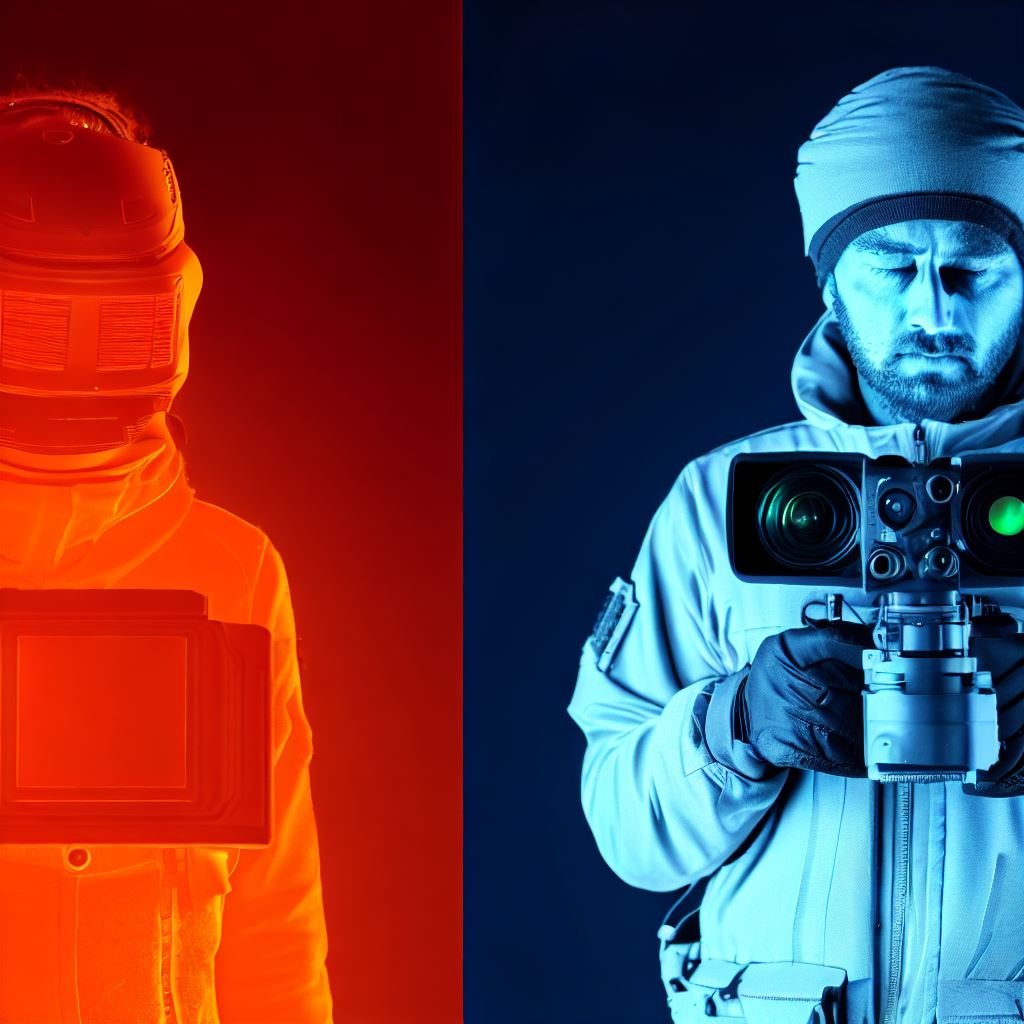

Have you ever wondered about the disparity between thermal imaging and night vision? These two technologies, often associated with the darkness, are frequently misunderstood.
In a nutshell, while night vision enhances the existing ambient light to enable clearer visibility in low-light conditions, thermal imaging detects and captures the heat emitted by objects to create a detailed image.
Both offer unique advantages and applications, and in this article, we will explore the dissimilarities between these two fascinating technologies.
Definition of Thermal Imaging
Thermal imaging is a technology that allows you to see and capture images of objects based on the infrared radiation they emit. Unlike regular cameras that rely on visible light, thermal imaging cameras use their ability to detect heat to create images.
This type of imaging enables you to visualize the temperature distribution of an object or a scene and identify variations in heat patterns.
How Thermal Imaging Works
Thermal imaging works by detecting and measuring the infrared radiation emitted by objects and converting it into a visible image. The cameras used in thermal imaging have heat-sensitive sensors called microbolometers, which detect the infrared radiation.
These sensors convert the infrared radiation into electrical signals, which are then processed and displayed as a thermographic image. The warmer an object is, the more infrared radiation it emits, and this is reflected in the thermal image.
Types of Thermal Imaging Cameras
There are various types of thermal imaging cameras available, each suited for different needs. Uncooled thermal imaging cameras are more common due to their cost-effectiveness and durability. They utilize microbolometers that do not require cooling.
On the other hand, cooled thermal imaging cameras use more advanced technology and require a cooling mechanism for their detectors, offering higher sensitivity and clearer images.
Definition of Night Vision
Night vision refers to the ability to see in low-light or dark conditions. It enhances your perception of the surroundings by amplifying the available light, making objects visible even in complete darkness. Night vision devices are commonly used in military operations, surveillance, and nocturnal wildlife observation.
How Night Vision Works
Night vision works by capturing and intensifying the existing available light, such as moonlight or starlight, and enhancing it. Night vision devices use an image intensifier tube, which consists of a photocathode that converts the incoming light into electrons.
These electrons are then accelerated and amplified, creating a visible image on a phosphor screen inside the device. This process allows you to see in low-light conditions that would otherwise be too dark for the naked eye.
Types of Night Vision Devices
There are primarily three types of night vision devices: image intensifiers, thermal imaging, and digital night vision. Image intensifiers work by amplifying the available light, making it possible to see even in near-total darkness.
Thermal imaging, as mentioned earlier, detects and visualizes the infrared radiation emitted by objects. Digital night vision uses a combination of technologies to capture and enhance nighttime images, often with the capability to record and display them in real-time.
Technology
Thermal Imaging Technology
Thermal imaging technology has made significant advancements over the years. The sensors used in thermal imaging cameras have become more sensitive and precise, allowing for higher resolution images and greater accuracy in temperature measurement.
The integration of infrared imagers with other technologies, such as artificial intelligence and machine learning, has further enhanced the capabilities of thermal imaging, enabling more sophisticated analysis and interpretation of thermal data.
Night Vision Technology
Night vision technology has also evolved rapidly, resulting in significant improvements in image quality and clarity. The image intensifier tubes used in night vision devices have become more efficient, providing better amplification of light and reducing distortion.
Additionally, digital night vision devices have become more popular due to their ability to capture and display images digitally, offering greater versatility and convenience.
Image Generation
Image Generation In Thermal Imaging
In thermal imaging, the generation of images is based on the detection and conversion of infrared radiation emitted by objects. The heat-sensitive sensors in thermal cameras measure the intensity of the infrared radiation, which is then converted into an electrical signal.
This signal is processed and mapped into a thermographic image, where variations in heat are represented by different colors or grayscale tones.
The resulting image provides a visual representation of the temperature distribution of the objects in the scene.
Image Generation In Night Vision
In night vision, the image generation process involves capturing and intensifying the available light, whether it is natural or artificial. The incoming light is converted into electrons by the photocathode in the image intensifier tube.
These electrons are then accelerated and multiplied, creating a visible image on the phosphor screen. The level of amplification and the characteristics of the phosphor screen determine the quality and clarity of the resulting image.
The image produced is typically a green-hued monochrome representation of the scene.
Light Source
Thermal Imaging Light Source
Thermal imaging cameras do not require any external light source to capture images. They rely on the objects themselves emitting infrared radiation, which is then detected and processed by the camera’s sensors.
This makes thermal imaging suitable for applications where there is low or no ambient light, such as in dark environments or during nighttime operations.
Night Vision Light Source
Night vision devices can operate with various light sources, both natural and artificial. In situations with sufficient ambient light, such as moonlight or starlight, night vision devices can function without any additional light source.
However, in extremely dark conditions, they may require an additional infrared illuminator, which emits light in the infrared spectrum.
This invisible light can then be amplified by the night vision device, allowing for improved visibility in complete darkness.
Applications
Applications Of Thermal Imaging
Thermal imaging has a wide range of applications across various industries and fields. In the realm of security and law enforcement, thermal imaging is used for surveillance, perimeter monitoring, and search and rescue operations.
It is also employed in building inspections, energy efficiency assessments, and electrical maintenance to identify insulation issues, overheating elements, or faulty connections easily.
In the medical field, thermal imaging is utilized in diagnostics, with its ability to detect differences in skin temperature aiding in early disease detection and monitoring.
Applications Of Night Vision
Night vision technology finds extensive use in military operations, enabling soldiers to navigate and detect potential threats in low-light or nighttime scenarios. It also plays a crucial role in law enforcement for surveillance, border control, and tactical operations.
Night vision is widely utilized in wildlife observation, allowing researchers and wildlife enthusiasts to study and observe nocturnal animals without disturbing their natural habitats.
Additionally, night vision devices have practical applications in recreational activities such as camping, hunting, and boating for enhanced visibility and safety during nighttime adventures.
Operating Environment
Operating Environment For Thermal Imaging
Thermal imaging cameras are versatile and can operate effectively in various environmental conditions. They are not affected by the presence or absence of visible light, so they can capture images in complete darkness or through obscurants such as smoke, fog, or dust.
Thermal imaging is also unaffected by reflections, which makes it suitable for applications where the target objects may be obscured or hidden from view.
Operating Environment For Night Vision
Night vision devices are designed to operate in low-light or dark conditions. They are most effective when there is some ambient light available, such as moonlight or starlight.
However, night vision can also function in total darkness with the help of an infrared illuminator. The performance of night vision devices may be affected by factors like extreme darkness, dense foliage, or artificial light sources that can cause glare or reflection.
Color Images
Color Images In Thermal Imaging
Traditional thermal imaging produces images in grayscale, where different shades of gray represent variations in temperature. However, advancements in technology have enabled the creation of thermal cameras capable of producing color images.
These cameras utilize advanced algorithms and image processing techniques to assign different colors to specific temperature ranges.
This colorization enhances the visualization and interpretation of thermal data, allowing for easier identification of thermal anomalies or patterns.
Color Images In Night Vision
Night vision devices typically produce monochrome images, usually green in color. This is because the phosphor screen used in image intensifier tubes is most sensitive to light in the green part of the spectrum.
However, with the introduction of digital night vision, it is now possible to capture and display color images.
Digital night vision devices use sensors that can capture both visible and infrared light, allowing for the production of full-color images even in low-light conditions.
Cost
Cost Of Thermal Imaging
The cost of thermal imaging cameras varies depending on various factors such as the resolution, sensitivity, features, and brand.
Entry-level thermal cameras can be relatively affordable, starting from a few hundred dollars, while high-end professional-grade thermal cameras can cost several thousand dollars.
Additionally, the cost of thermal imaging is also influenced by the specific applications and industry requirements, such as specialized thermal cameras used in research or industrial inspections.
Cost Of Night Vision
The cost of night vision devices also ranges depending on the type and quality of the device. Entry-level night vision devices, such as basic monoculars or binoculars, can be relatively affordable, ranging from a hundred to a few hundred dollars.
However, more advanced night vision goggles or scopes used in professional applications can range from several hundred to thousands of dollars.
The cost may also vary based on additional features, such as digital recording capabilities or integrated technologies.
Limitations
Limitations Of Thermal Imaging
While thermal imaging is a powerful tool, it does have some limitations. One major limitation is its inability to provide fine details or sharp images of objects.
Thermal cameras primarily visualize temperature differences rather than capturing precise details like a traditional camera.
Additionally, the performance of thermal imaging is influenced by factors such as atmospheric conditions, emissivity of materials, and distance to the object.
These factors can affect the accuracy and reliability of temperature measurements and image interpretation.
Limitations Of Night Vision
Night vision devices also have certain limitations to consider. One limitation is their susceptibility to glare or bright light sources, which can temporarily blind or damage the image intensifier tube.
When using night vision devices, it is essential to avoid exposure to intense light sources, as they can cause discomfort or adverse effects.
Additionally, even though night vision enables visibility in low-light conditions, it may not entirely compensate for complete darkness or pitch-black environments, requiring the use of additional infrared illuminators in such cases.
Is It Legal To Hunt With A Crossbow?
What Kind Of Crossbow Is Used For Deer Hunting?
What Brand Of Crossbow Is Best?





